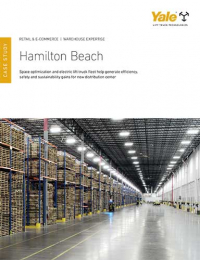CBRE data points to e-commerce-driven need for another 330 million square-feet in U.S. by 2025
Latest Material Handling News
Lucas Watson appointed CSO for Körber’s Parcel Logistics business in North America Hyster recognizes Dealers of Distinction for 2023 Carolina Handling names Joe Perkins as COO Walmart deploying autonomous lift trucks at four of its high-tech DCs Kathleen Phelps to join FORTNA as chief financial officer More NewsEven though the most-dire days of the COVID-19 pandemic may be in the past, that, by no means, has pumped the brakes on the frenetic pace of e-commerce activity, driven by the steady drum beat of consumer demand.
That was evident in the findings of a report recently issued by Los Angeles-based industrial real estate developer CBRE. A main finding of the report, entitled “Global E-Commerce Outlook: What is Driving E-Commerce Growth in Different Markets?” stated that with e-commerce penetration poised to hit 26% of total retail sales by as soon as 2025, the United States will require an additional 330 million square-feet of distribution space to keep up with the projected e-commerce demand over that period.
That additional 330 million square-feet accounts for 27% of total projected overall demand for United States industrial real estate space through 2025, according to CBRE.
The firm explained that its forecast, which is based on Euromonitor data for 2020, estimates that every additional $1 billion of e-commerce sales accounts for 1 million square-feet of new distribution space. And it also noted that U.S. e-commerce sales are pegged to head up $330 billion from 2020-2025, with global e-commerce sales, for the same period, pegged to increase by $1.5 trillion, which, in turn, will require another $1.5 billion square-feet of warehouse and distribution space, with the United States and Mainland China collectively representing 57% of global e-commerce sales.
“While there is a sizable construction pipeline in the U.S., much of that new space already is leased to meet the demand of the past few years,” said James Breeze, Senior Director and Global Head of Industrial & Logistics Research for CBRE, in a statement. “Moving forward, the challenge in many U.S. and global markets will be to produce enough new facilities to meet this rapidly expanding market. It’s important to bear in mind that e-commerce is only a portion of the overall demand for distribution facilities. Traditional retailers, third party logistics companies and others will also be demand catalysts. If developers can’t build facilities fast enough, we could see rental rates push well beyond their current record highs.”
CBRE Director of Research Matt Walaszek told LM the pandemic clearly accelerated this trend, in terms of how far ahead of schedule CBRE’s projections are, noting that some estimates say it pulled forward e-commerce growth by three-to-five years.
“This was happening already, but the pandemic certainly led to a proliferation of e-commerce as older generations adopted this new way of shopping,” he said. “In-store sales are rebounding as economies open back up, however, we believe e-commerce will continue on an upward trajectory more so than was previously estimated.”
When asked what the biggest logistics goals and challenges are in adding this needed space by 2025, Walaszek said that those goals include developing enough warehouse and distribution space to keep up with demand, with near term threats evident, such as supply chain volatility and sourcing materials used in construction.
“Nevertheless, much of this is expected to subside later this year and into 2022,” he said. “Going forward, from the development perspective, competition from other uses will make it increasingly difficult to build warehouse space and therefore challenging for companies (general retails/wholesalers, 3PLs, and of course pure play e-commerce) looking to lease space. For example, multifamily, life sciences and data centers will compete with industrial for available land sites, as well as conversion opportunities around the country. With regard to life sciences and data centers, investors are targeting these ‘alternative’ assets given demographic and technological changes as well as the development of new vaccines and need for more lab/R&D space.”

Article Topics
Latest in Materials Handling
Lucas Watson appointed CSO for Körber’s Parcel Logistics business in North America Hyster recognizes Dealers of Distinction for 2023 Carolina Handling names Joe Perkins as COO C-suite Interview with Keith Moore, CEO, AutoScheduler.AI: MODEX was a meeting place for innovation Walmart deploying autonomous lift trucks at four of its high-tech DCs Coles shops big for automation Kathleen Phelps to join FORTNA as chief financial officer More Materials HandlingAbout the Author
Subscribe to Materials Handling Magazine

Find out what the world's most innovative companies are doing to improve productivity in their plants and distribution centers.
Start your FREE subscription today.
April 2024 Modern Materials Handling

Latest Resources










